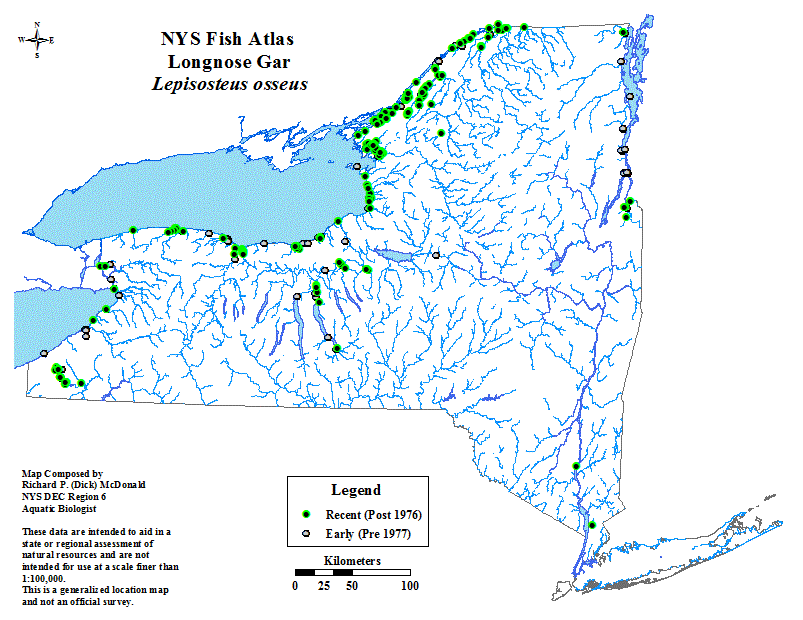Gar Family
Lepisosteidae

Longnose Gar (Lepisosteus osseus)
Gar have lived in North American waters for 50 million years, and continue to do so today without attracting much attention. Fossil gar found in rocks from the Green River formation of western Wyoming are so similar to gar found today in New York waters that they are considered to be members of the modern genus Lepisosteus. Although gar are often characterized as "primitive" fish, their ability to survive without change demonstrates that their body form and life history characteristics remain successful in modern aquatic habitats.
Gar are long, cylindrical fish with distinctive long jaws containing needlelike teeth. Most modern gar live within shallow, vegetated freshwater habitats, although some species frequent brackish and marine coastal waters. Their fins are arranged to generate quick bursts of speed useful for ambushing prey. Gar are covered with hard, diamond-shaped ganoid scales that are covered with ganoin, an enamel-like substance that takes a high polish. These ganoid scales form a tough, shell-like armor that protects adult gar from many predators.
A unique characteristic of gar is their ability to breathe atmospheric air. The gar swim bladder is connected to the esophagus and operates as a primitive lung, and the inner lining of the swim bladder is cellular and somewhat roughened, thereby facilitating gas-absorption. Gar have been observed to rise to the water surface where they release a bubble of air before swallowing another air bubble, then sink slowly below the surface. This ability to breathe air at the surface allows gar to live in low-oxygen conditions frequently found in shallow, freshwater habitats associated with coastal wetlands.
The longnose gar is found in relatively large lakes throughout New York, such as Lake George, Lake Champlain, Cayuga Lake and Chautauqua Lake. Longnose gar are also found in both Lakes Erie and Ontario, as well as within connecting waters of the Niagara and St. Lawrence Rivers and the mouths of large tributaries. Adult longnose gar reach lengths of 3 - 4 feet.
Gar inhabit warm, shallow areas where they prey upon fish up to one-third of their own length. Adult gar have the habit of basking near the surface on warm days or nights, where they resemble floating pieces of wood or dead vegetation. Longnose gar feed most actively at night. They stalk fish victims by moving sideways towards their prey, resembling a stick floating in a surface current. Prey fish are typically captured sideways in a gar's long jaws, then prey are turned so that they can be swallowed head first.
Gar spawn in the spring by broadcasting their adhesive eggs in shallow water where the eggs attach to vegetation, after which they provide no parental care.
Distribution of longnose gar in NY state.
A larger image of the longnose gar is also available for download.
